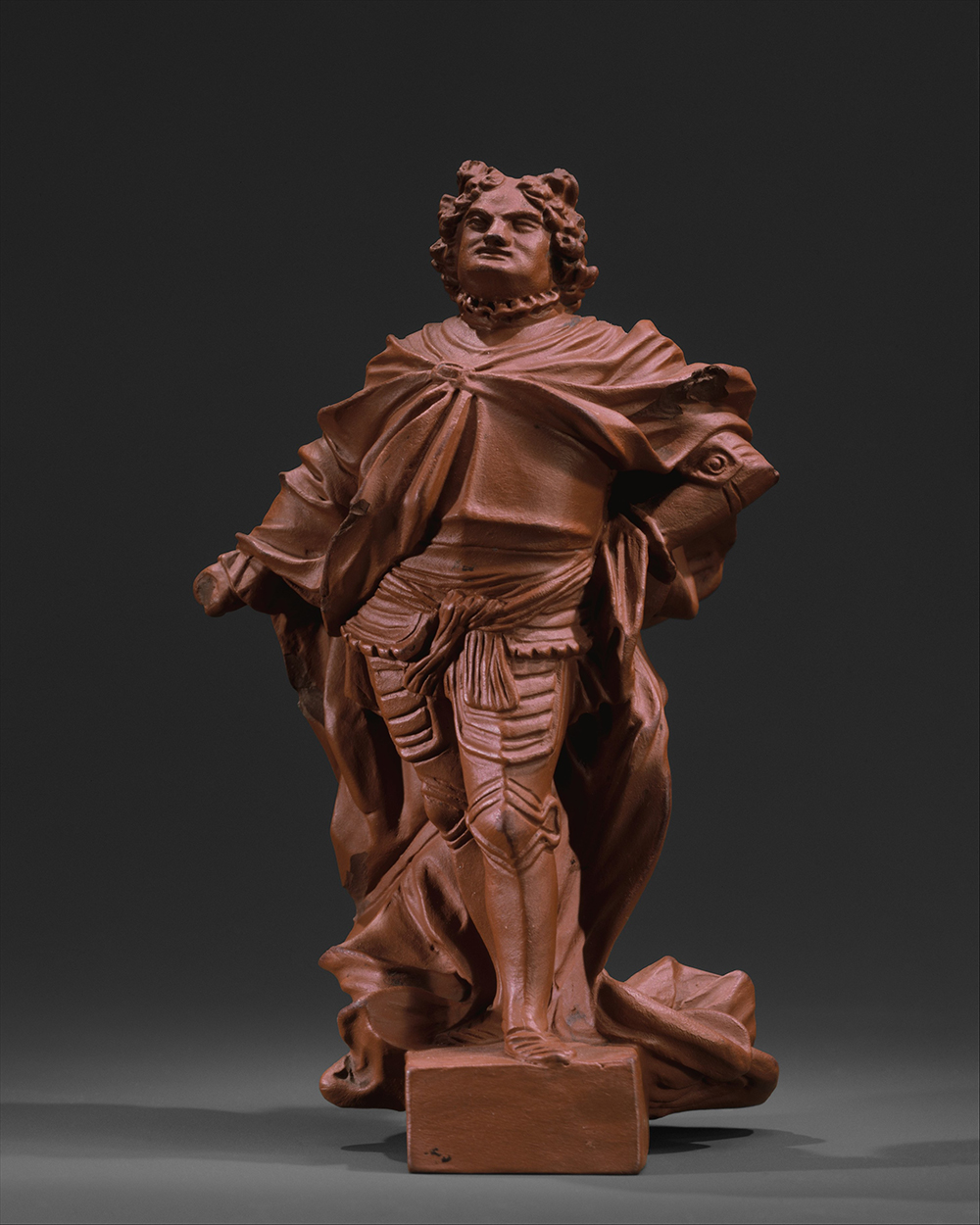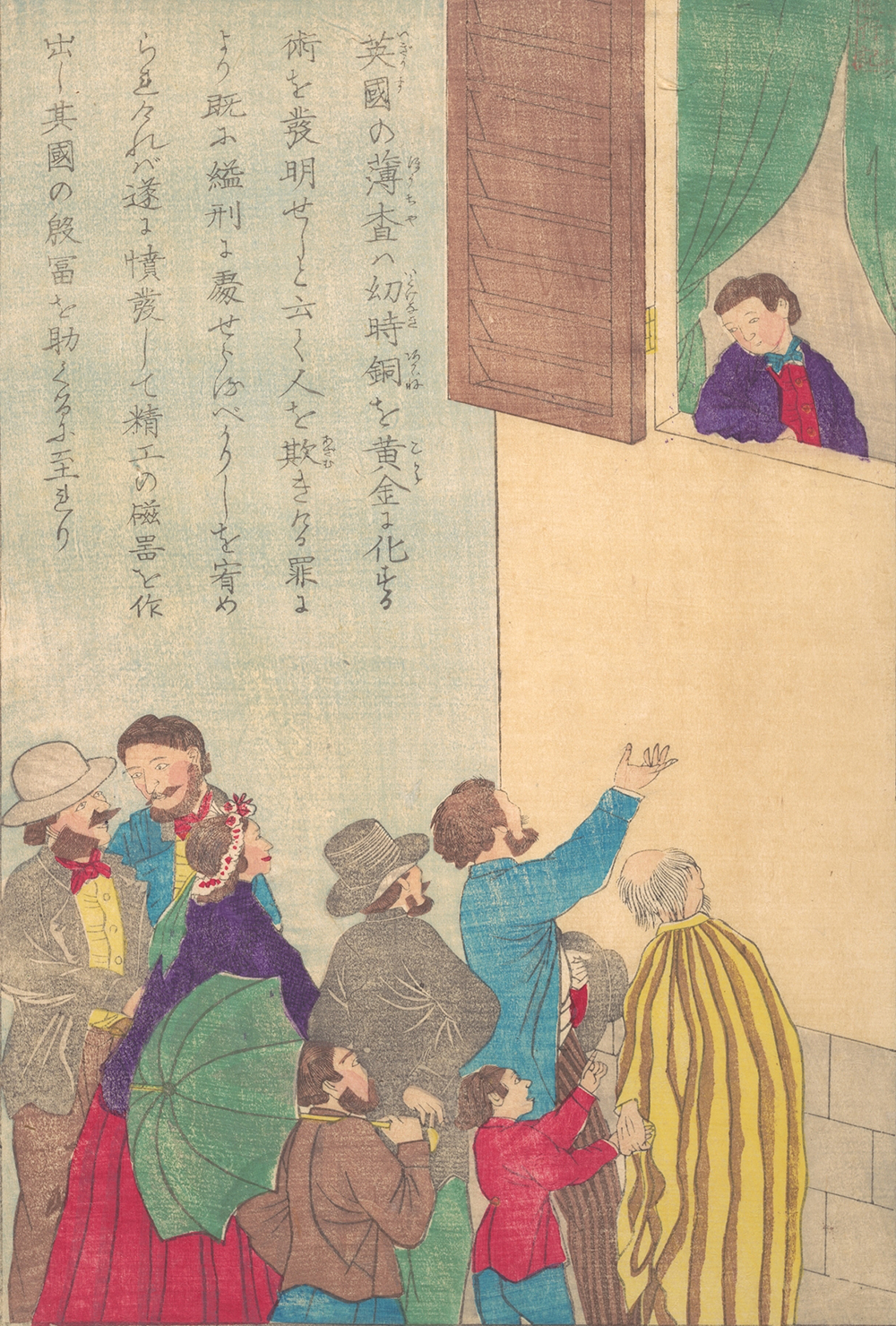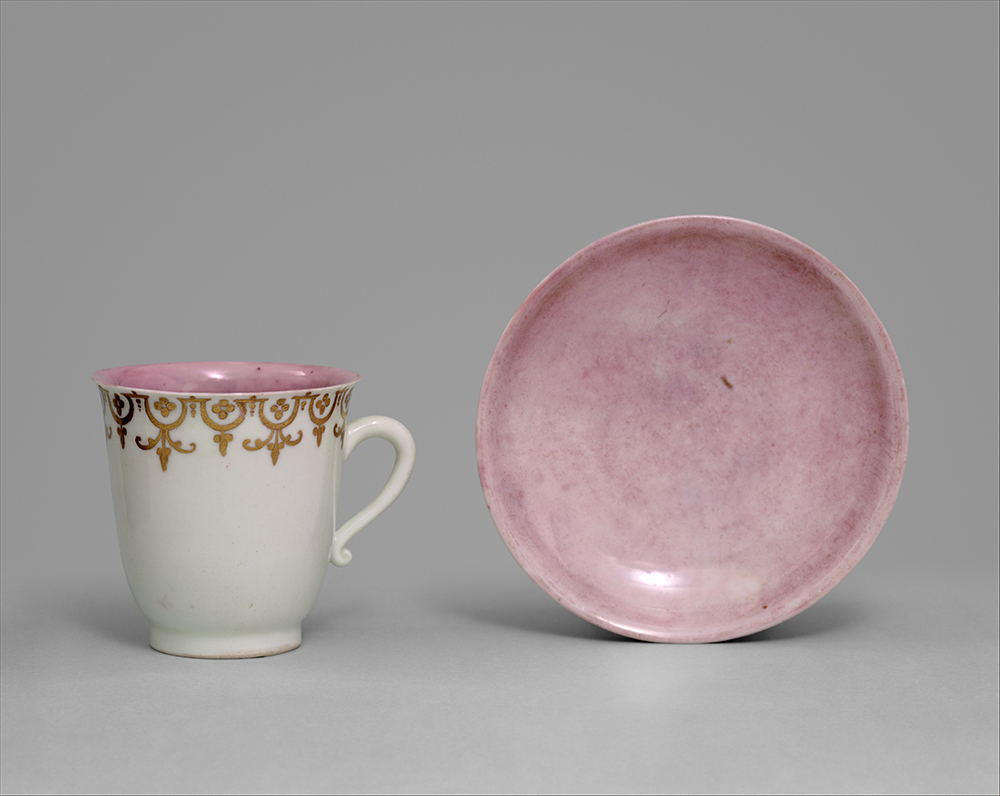
Beaker vase by the Meissen Manufactory, c. 1713. The Metropolitan Museum of Art, gift of Mrs. George B. McClellan, 1941.
The German alchemist Johann Friedrich Böttger (1682–1719) was a nobody. Yet Böttger was lucky enough to have been born the son of the mint keeper in Schleiz, and to have relatives willing and able to help him; in early modern society, family resources were crucial to individuals’ success. When Johann’s father lost his job, the family moved to the Prussian town of Magdeburg to share quarters with his brother, a prosperous goldsmith. After his father’s death, Johann was again fortunate in his stepfather, a well-to-do engineer and bureaucrat who could afford to give Johann what was for the time a very good bourgeois education and pay for his apprenticeship to an apothecary in Berlin. Here the ambitious teenager demonstrated an aptitude for experiment—and a penchant for ignoring rules. His apprenticeship brought him into contact with a number of men engaged in the alchemical search for the philosopher’s stone, the mineral compound that, it was believed, could be combined with base metals to make gold. Böttger, too, became obsessed with this quest. Having received some ingredients and instructions from a mysterious wandering Greek monk, this swaggering nobody made a fateful boast: while the wisest of scholars for centuries had failed in this esoteric endeavor, he had discovered the secret to making gold.
Böttger’s boast was not so implausible at the time. Suffused with mystical and magical elements, alchemy nonetheless counted as a “science,” and like Böttger’s Berlin friends, many of the leading scientists of the day, including Sir Isaac Newton, expended much energy and effort in the hopes that their alchemical experiments would succeed. Moreover, investment in alchemical research made sense, above all for nations experienced in smelting precious metals, but also for poorer states seeking a quick fix for depleted treasuries. Evidently Böttger’s demonstrations were convincing enough that rumors began to spread, and in 1701 they reached the ears of the Prussian elector (soon to become Frederick I, king of Prussia), eager to employ an alchemist to help him make more gold to finance his lavish tastes, his sizable army, and his big debts. Frederick commanded Böttger to report to him in Berlin.
Fearful he would be punished for his magic tricks, Böttger abandoned his apprenticeship and went into hiding—and then made a dash for the border. This put him beyond the long arm of the Prussian elector but regrettably delivered him into the clutches of Saxony’s elector Augustus the Strong, who was also in great need of funds, to feed his collecting habits as well as to keep himself on the Polish throne. On learning that an alchemist had entered his territory, Augustus promptly had Böttger arrested, with the same aims as those of his Hohenzollern neighbor. To prevent the young alchemist from being kidnapped by Prussian soldiers or from running away, Augustus now locked him in a Saxon prison. The prisoner was comfortably accommodated and provided with materials, books, and lavish meals; he was allowed to entertain many of the state’s leading scholars, including the senior scientist and courtier Ehrenfried Walther von Tschirnhaus (1651–1708). Meanwhile, the Saxon elector impatiently awaited news that his real-life Rumpelstiltskin had turned dross into gold.

Making gold, it turned out, required steep initial investments, and by 1703 Augustus had already plunged forty thousand taler into this endeavor: the equivalent of a very respectable annual wage for some four thousand men. It was only in this year, however, perhaps thanks to Tschirnhaus’ intervention, that Böttger was allowed to depart his gilded cage and move operations to the Goldhaus, a fully equipped alchemist’s laboratory just meters from the electoral palace in Dresden. Here Böttger had access to the latest equipment and to a fully stocked scientific library; he was also allowed to hire some skilled craftsmen to assist him. He moved into apartments in the palace and was given space for a billiards room and freedom to walk in the palace gardens, although if he got too close to the gate, his guards were instructed to shoot pellets at him from a blowpipe.
Böttger’s move to the Goldhaus enabled him to do better science, but it was his collaboration with the much older Tschirnhaus that was crucial to his scholarly success and saved him from execution for having perpetrated a fraud. A skilled mathematician and chemist, the Silesian-born Tschirnhaus had studied medicine, mineralogy, chemistry, and philosophy at the University of Leiden. He had then proceeded to Paris, where he took a job as tutor to Louis XIII’s finance minister Jean-Baptiste Colbert’s son, fell under the spell of mercantilist ideas, and was introduced to experiments in porcelain making. In Louis XIV’s capital and in the course of his travels he had also befriended experts in the chemical properties of glass. He had made intensive studies of burning mirrors, which enabled the melting and assaying of materials at high temperatures. Linked to the Saxon court by his wife’s connections, the cosmopolitan Tschirnhaus had settled in Dresden and become one of a number of scholars at Augustus’ court. Like the leading scientists of the day, Tschirnhaus was interested in alchemy, but he prioritized the practical political aim of improving Saxon industries such as marble polishing, glassblowing, and, if possible, porcelain making. By 1694 at the latest he was using his burning lenses to melt delftware and Chinese porcelain in pursuit of its recipe. In 1701–2, he arranged visits to St. Cloud in France and to delftware workshops in the Netherlands, and he learned about French experiments with mixtures using eggshells, snail shells, and chalk. Tschirnhaus himself pioneered a process to fuse chalk and quartz, a process at the heart of porcelain making, and he was unhappy to leave aside his own projects when Augustus tasked him with speeding up Böttger’s science. But assisting this “nobody” gave him the opportunity to explore high-temperature firing, and the development of ceramic crucibles for gold making was an enterprise this odd couple could work on in tandem. When, in May 1706, they succeeded in turning out a hard red ceramic paste that resembled the Yixing porcelains already in Augustus’ and other princely collections, it was surely Tschirnhaus who recognized that the right recipe for the most desired white porcelain was within reach and who persuaded both Böttger and the elector to pursue this more probable concoction while putting the longer-term project of making gold on the back burner.
We should not, however, diminish the contributions made by our nobody. Böttger, by all accounts, was a chemical prodigy and, by dint of many failed efforts, became an expert kiln builder, a highly important part of his “magic.” Thus Böttger was the inventive technician and hands-on experimenter, Tschirnhaus his scholarly consultant. They set to work, officially in pursuit of gold, but increasingly of the porcelain recipe. In 1707 the team devoted itself to perfecting the vitrified red stoneware that would subsequently be known as Böttger stoneware, as well as to formulating the elusive recipe for the most coveted white porcelain.
In March 1709 Böttger was confident enough to announce to the king that he was now able to make porcelain “as good as that of the Chinese, if not better.” Notwithstanding subsequent monumentalizations of this moment, this remained a premature boast. Only in 1713 could the Saxons more or less reliably fire white porcelains, and it took much longer to perfect the glazes and underglaze enamels that could rival East Asian wares.

Böttger’s claim—to have made porcelain “as good as that of the Chinese”—should remind us that this “invention” was in fact an imitation of the Chinese and Japanese porcelains already owned by Augustus and other princes. Augustus had long been buying vast quantities of imported porcelain; Böttger’s findings simply enabled Saxony to replicate these imports, something that is clearly evident in our real-life Rumpelstiltskin’s first products, which initially copied Asian shapes as exactly as possible—Böttger, after all, was a chemist, not a potter. But imitations were welcome, both to the porcelain-mad prince and to the minders of the royal treasury. The elector longed to enhance his own collection, as well as to demonstrate his state’s artistic and technological prowess; his financial advisers welcomed the reduction of the king’s expenditures on costly imports. Thus Augustus moved Böttger and his operations to the old Wettin castle in Saxony’s former capital of Meissen, about fifteen miles from Dresden, where production could begin in earnest, and perhaps more than ever, in secret.
The “factory” Augustus bestowed on Böttger was in fact the disused Albrechtsburg Castle, walled and sited on the top of a hill overlooking the Elbe River. Here Böttger once again built a kiln and set up a horse mill to grind paste and glaze materials. At first production was devoted to the more easily fired red “Böttger Steingut,” shaped after Yixing models from the elector’s collection. In 1710 many pieces of this “stoneware” and samples of white porcelain could be exhibited at the Easter fair in Leipzig, though, somewhat ominously, only about half the inventory sold. A master silversmith was hired to oversee the artistic side of production and soon added pieces made after baroque silver. Böttger also secured exclusive rights from Aue to its all-important kaolin clay, which was sent in boxes marked with crossed swords and the letters A and R (Augustus Rex), the first appearance of what would evolve into Meissen’s trademark. By 1711 the Meissen works employed more than thirty men and had produced more than twelve thousand pieces ready for sale, virtually all of them made of red “Böttger” stoneware. A mercantile industry had been born.
This was, however, not an “industry” in the nineteenth-century sense, and if moneymaking was its object, the whole enterprise was a laughable disaster, at least during Böttger’s lifetime. Böttger was paid a princely 50 taler a month and, from 1715 until his death in early 1719, served as the manufactory’s leaseholder. But frequently ill and falling ever deeper into alcoholism, he now lived in Dresden and visited the works irregularly.
Augustus clearly aimed to make a big show of his porcelain, as the plans for his never-completed “Japanese Palace” indicate. This structure, across the Elbe from his Dresden residence, was to feature at least eighteen lavish rooms; the lower level was to be wallpapered with thousands of imported Chinese and Japanese porcelains, the upper to be plastered in Meissen products, one room celadon and gold, the next purple and gold, others gray and blue. Augustus’ porcelain menagerie of life-sized birds and animals was also to reside on the top floor. If he found porcelains endlessly delightful, Augustus would discover that they also made excellent gifts, cheaper than jeweled swords, and versatile enough to employ both in charming foreign princes and in rewarding domestic officials. Augustus himself would become the firm’s best, and worst, customer: “best” in terms of his enormous number of orders, “worst” in that he failed to pay the manufactory for most of them.

In 1714 Böttger officially received his freedom, on the condition that he remain in Saxony and keep the Arcanum a secret. His health was poor, his alcoholism ever more pronounced, his finances chaotic. He was still closely watched by Augustus’ spies. By 1717 Böttger and his staff were working hard on blue underglaze paintings and the application of gold and silver decoration to their vessels, but the arcanist was too ill to do much, or to care much, about the conditions of the factory, where pay continued to be in arrears and morale low. Poisoned both by drink and by the substances with which he tinkered, Böttger expired in March 1719. At his death he owed 8,564 taler in personal obligations, and his manufactory had outstanding debts of nearly three times that amount, not including back wages owed to his workers.
Excerpted from Porcelain: A History from the Heart of Europe by Suzanne L. Marchand. Copyright © 2020 by Princeton University Press. Reprinted by permission. The excerpt is presented here without footnotes or references, all of which can be found in the published book.
